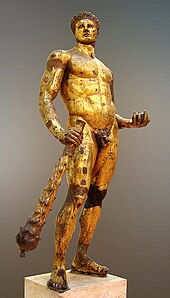Hercules of the Forum Boarium

Hercules of the Forum Boarium is one of two gilded bronze statues of
Description
The bronze sculpture is slightly over life-sized
Subject

The statue of Hercules from Forum Boarium is based on his twelve labors where he must bring back the Golden Apples of Hesperides to Eurystheus. Hercules found Prometheus during his search and freed him from his prison. In return, Prometheus told him where he could find the Golden Apples. The apples were guarded by a hundred-headed dragon named Ladon who could not be conquered by Hercules. To defeat Ladon, he needed the help of Atlas, the titan that held the Earth and Heavens on his shoulder. Hercules managed to convince Atlas to help him get the apples, but in exchange, Hercules would have to carry the weight of the world while Atlas acquired the apples. When Atlas returned with the apples, he did not want to retake the weight of the world back. Hercules tricked Atlas by saying that he would gladly stay and hold up the world, but asked Atlas if he could take the weight again so he can adjust his cloak. Atlas took back the weight of the world and Hercules immediately picked up the Golden Apples and ran off.[3]
History
The temple of the Forum Boarium in Rome is located by the
Notes
- ^ Height 2.41 m.
- ^ .
- ^ Symmachus, Aurelius. "The Temple of Hercules". www.roman-empire.net. Archived from the original on 2006-01-04. Retrieved 2017-12-14.
- ^ Eugène Müntz, Les arts à la cour des papes pendant le XVe et le XVIe siècle, vol. III:177f.
- ^ inv. no. MC1265; Haskell and Penny 1981:227
- ^ Fabio, Barry (March 2011). "The Mouth of Truth and the Forum Boarium: Oceanus, Hercules, and Hadrian". The Art Bulletin. 93 (1) (Vol. 93, No. 1 ed.). College Art Association: 17–19.
- ^ "Hercules Mastai".
References
- Haskell, Francis, and Nicholas Penny, 1981. Taste and the Antique: The Lure of Classical Sculpture 1500-1900 (Yale University Press) Cat. no. 45.
- Platner, Samuel Ball, and Thomas Ashby, 1926. A Topographical Dictionary of Ancient Rome, (London: Oxford University Press): "Aedes Herculis Victoris" (On-line text)
External links
- Dr Mary Ann Sullivan, "Hercules, Capitoline Museum" Photographs of the Hercules
